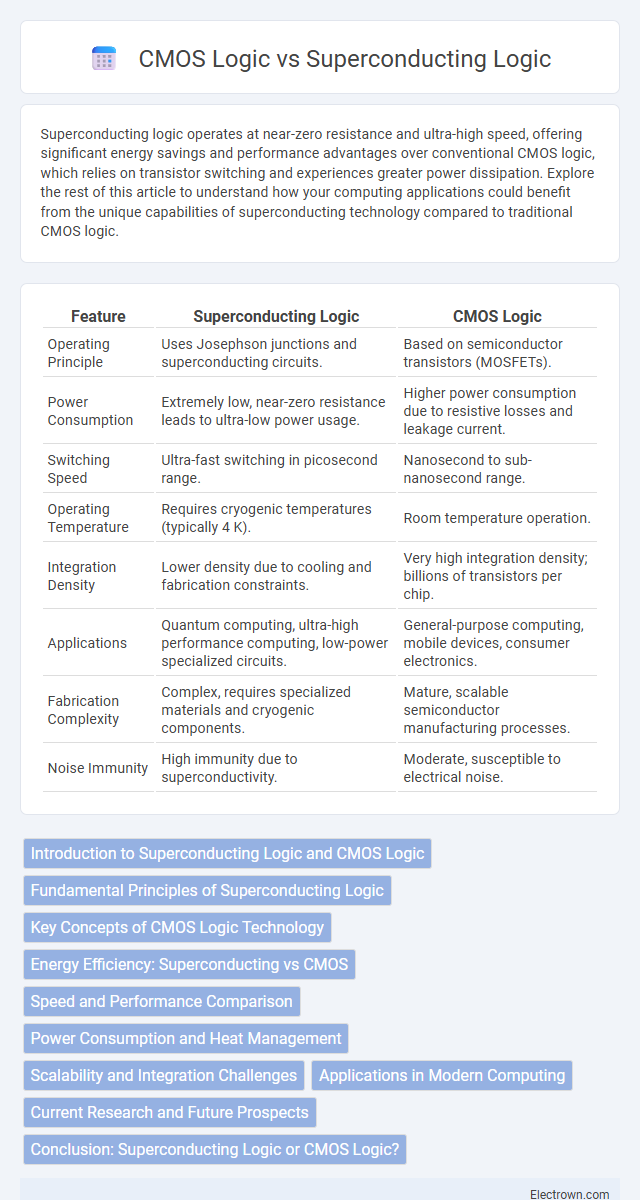Superconducting logic operates at near-zero resistance and ultra-high speed, offering significant energy savings and performance advantages over conventional CMOS logic, which relies on transistor switching and experiences greater power dissipation. Explore the rest of this article to understand how your computing applications could benefit from the unique capabilities of superconducting technology compared to traditional CMOS logic.
Table of Comparison
| Feature | Superconducting Logic | CMOS Logic |
|---|---|---|
| Operating Principle | Uses Josephson junctions and superconducting circuits. | Based on semiconductor transistors (MOSFETs). |
| Power Consumption | Extremely low, near-zero resistance leads to ultra-low power usage. | Higher power consumption due to resistive losses and leakage current. |
| Switching Speed | Ultra-fast switching in picosecond range. | Nanosecond to sub-nanosecond range. |
| Operating Temperature | Requires cryogenic temperatures (typically 4 K). | Room temperature operation. |
| Integration Density | Lower density due to cooling and fabrication constraints. | Very high integration density; billions of transistors per chip. |
| Applications | Quantum computing, ultra-high performance computing, low-power specialized circuits. | General-purpose computing, mobile devices, consumer electronics. |
| Fabrication Complexity | Complex, requires specialized materials and cryogenic components. | Mature, scalable semiconductor manufacturing processes. |
| Noise Immunity | High immunity due to superconductivity. | Moderate, susceptible to electrical noise. |
Introduction to Superconducting Logic and CMOS Logic
Superconducting logic leverages zero-resistance materials at cryogenic temperatures to achieve ultra-fast switching speeds and extremely low power dissipation, offering significant advantages over conventional CMOS logic. CMOS logic, based on complementary pairs of p-type and n-type MOSFETs, dominates current semiconductor technology due to its scalability, low static power consumption, and mature manufacturing processes. Understanding the fundamental operational principles and physical characteristics of both superconducting and CMOS logic is crucial for evaluating their potential in next-generation computing systems.
Fundamental Principles of Superconducting Logic
Superconducting logic relies on quantum phenomena such as zero electrical resistance and the Josephson effect to enable ultra-fast switching with minimal energy dissipation. Unlike CMOS logic, which operates on semiconductor transistors controlling current flow through silicon-based materials, superconducting logic uses superconducting loops interrupted by Josephson junctions to represent and process digital information. Your ability to leverage superconducting logic hinges on exploiting these quantum effects to achieve significantly higher speed and energy efficiency in digital circuits.
Key Concepts of CMOS Logic Technology
CMOS logic technology relies on complementary pairs of p-type and n-type MOSFETs to create low-power, high-density integrated circuits, enabling efficient digital signal processing. Device miniaturization and threshold voltage scaling enhance switching speeds while reducing static power consumption, crucial for modern microprocessors and memory chips. Advanced CMOS technology incorporates multi-gate transistors and high-k dielectrics to mitigate short-channel effects and improve device reliability in nanoscale regimes.
Energy Efficiency: Superconducting vs CMOS
Superconducting logic circuits consume significantly less energy than CMOS logic due to near-zero electrical resistance, resulting in minimal power dissipation during operation. Unlike CMOS, which relies on semiconductor junctions that generate heat and limit energy efficiency, superconducting devices use quantum interference to switch states with extremely low energy loss. Your electronic systems could achieve substantially improved energy efficiency and reduced thermal management demands by adopting superconducting logic technologies.
Speed and Performance Comparison
Superconducting logic circuits achieve switching speeds in the picosecond range, significantly surpassing CMOS logic, which typically operates in the nanosecond domain. The ultra-low energy dissipation in superconducting devices enables higher clock frequencies and reduced thermal noise, directly enhancing computational throughput. CMOS logic, constrained by semiconductor material properties and heat generation, cannot match the performance consistency of superconducting logic under high-speed conditions.
Power Consumption and Heat Management
Superconducting logic circuits consume significantly less power compared to CMOS logic due to near-zero electrical resistance, leading to minimal energy loss and heat generation. This ultra-low power consumption reduces cooling requirements and enhances heat management, making superconducting technology more efficient for high-performance computing applications. Your system can benefit from lower operational temperatures and improved energy efficiency when utilizing superconducting logic over traditional CMOS logic.
Scalability and Integration Challenges
Superconducting logic faces significant scalability and integration challenges due to the requirement of maintaining cryogenic temperatures and the complexity of integrating with existing semiconductor technologies. CMOS logic benefits from mature fabrication processes and room-temperature operation, enabling high-density integration and scalability across a wide range of applications. However, efforts to scale superconducting circuits focus on overcoming thermal management and interconnect issues to achieve practical integration with conventional CMOS systems.
Applications in Modern Computing
Superconducting logic offers ultra-fast switching speeds and near-zero energy dissipation, making it ideal for high-performance computing applications such as quantum computers, cryogenic data centers, and supercomputing accelerators. CMOS logic remains dominant in general-purpose computing due to its mature fabrication processes, scalability, and integration with existing semiconductor technologies. Emerging hybrid systems combine superconducting and CMOS logic to leverage energy efficiency and speed in specialized tasks like AI inference and large-scale simulations.
Current Research and Future Prospects
Current research in superconducting logic explores ultra-low power consumption and near-zero resistance to overcome CMOS scaling limitations, utilizing materials like niobium and innovative qubit designs for enhanced quantum computing integration. Advances in rapid single flux quantum (RSFQ) and reciprocal quantum logic (RQL) circuits aim to significantly increase switching speeds and energy efficiency compared to traditional silicon-based CMOS technology. Future prospects emphasize hybrid architectures combining superconducting and CMOS logic to optimize computational performance and enable scalable, high-speed, and energy-efficient systems for next-generation electronics.
Conclusion: Superconducting Logic or CMOS Logic?
Superconducting logic offers unparalleled speed and energy efficiency for specialized applications, making it ideal for quantum computing and advanced signal processing where minimal power consumption and ultra-fast switching are critical. CMOS logic remains the dominant choice for general-purpose computing due to its mature fabrication technology, scalability, and cost-effectiveness in mass production. Your selection depends on whether you prioritize cutting-edge performance in niche markets or widespread compatibility and affordability.
superconducting logic vs CMOS logic Infographic

 electrown.com
electrown.com